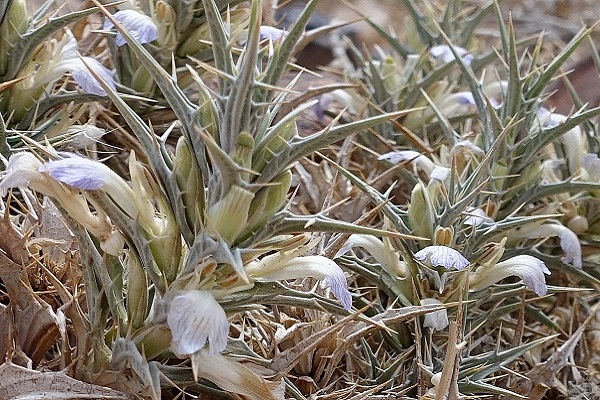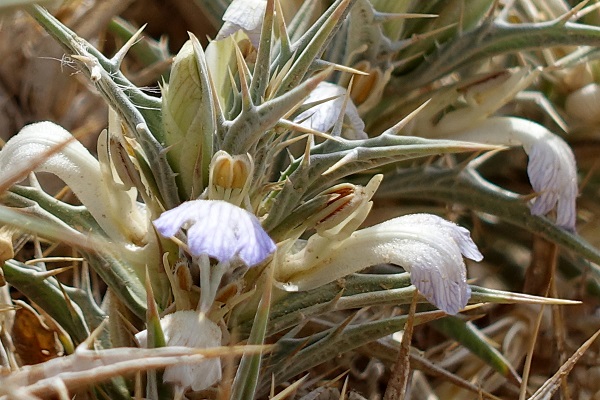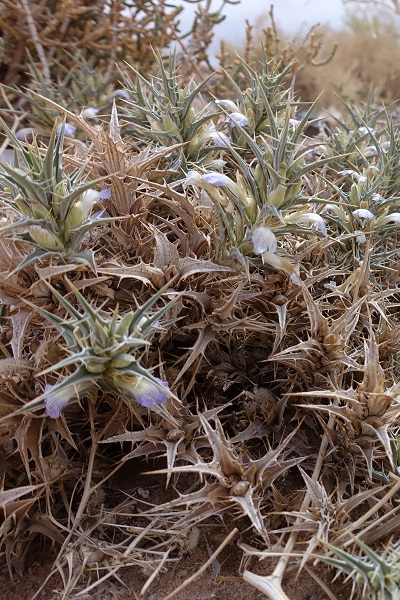Hebrew: ריסן דק, Arabic: شوك الضب الرقيق
| Scientific name: | Blepharis attenuata Napper | |
| Synonym name: | Blepharis ciliaris (sensu Fenbrun-Dothan 1978) | |
| Common name: | Blepharis attenuata | |
| Hebrew name: | ריסן דק | |
| Arabic name: | شوك الضب الرقيق | |
| Family: | Acanthaceae, Acanthus family, קוציציים |

|
| Life form: | Chamaephyte | |
| Spinescence: | Leaves | |
| Stems: | After 6 leaves appeared, the main stem terminated with the first inflorescence of flower buds | |
| Leaves: | Opposite, dissected, dentate or serrate margin | |
| Inflorescence: | Terminal inflorescence, each inflorescence survives about 1 year, and later dries out. | |
| Flowers: | Hermaphrodite, 4 sepals, 2 of them are small and lateral and, of the other 2, there is 1 upper and 1 lower sepal which cover the monolobial blue corolla with darker arteries, rarely white | |
| Fruits / pods: | Hard capsule with 2 seeds | |
| Flowering Period: | May, June, July, August, September, October, November, December | |
| Habitat: | Batha, Phrygana, Desert | |
| Distribution: | Mediterranean Woodlands and Shrublands, Shrub-steppes, Deserts, Semi-steppe shrublands | |
| Chorotype: | Irano-Turanian-Saharo-Arabian | |
| Summer shedding: | Perennating |

Derivation of the botanical name: Blepharis, Greek βλεφαριϛ eyelash, relating to eye-lashes or eye-lids. attenuata, Latin attenuatus, weak, meagre, reduced. ciliaris, Latin cilium = eyelash. The Hebrew name: ריסן דק, risan dak, risan from risim, eyelashes, cilia, marginal hairs; dak means thin; thin marginal hairs.
Blepharis is an Afro-asiatic genus comprising 129 species, belonging to the family Acanthaceae, widely distributed in arid and semi-arid habitats. These plants exhibit a wide range of pharmacological activities including antioxidant, anti-inflammatory, anti-arthritic, antimicrobial, antifungal, anti-ulcer and cytotoxic activities. One of the species include Blepharis attenuata Napper, but has not yet been extensively studied for its medical properties. The first flowerbuds appear when 6 leaves are formed. Two lateral branches develop from the axis of the upper pair of leaves, beneath the terminal inflorescence. Each of them develop 4 leaves and later on also terminal inflorescence. In addition, 2 branches, 4 leaves, and a terminal inflorescence develop from the axis of the upper pair of leaves, and thus the proces continues. This pattern of growth and inflorescence development is simular in all Blepharis species. The higher the temperature, the shorter the time to flowering. *Handbook of Flowering, Volume 6, Abraham H. Halevy, CRC Press, 31 Aug 1989. 
|